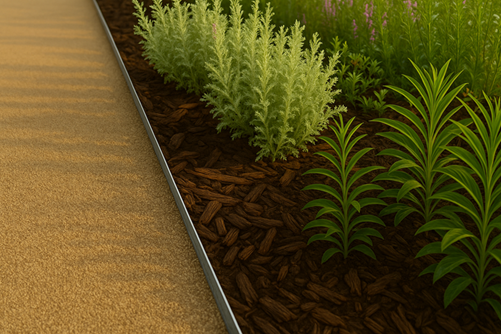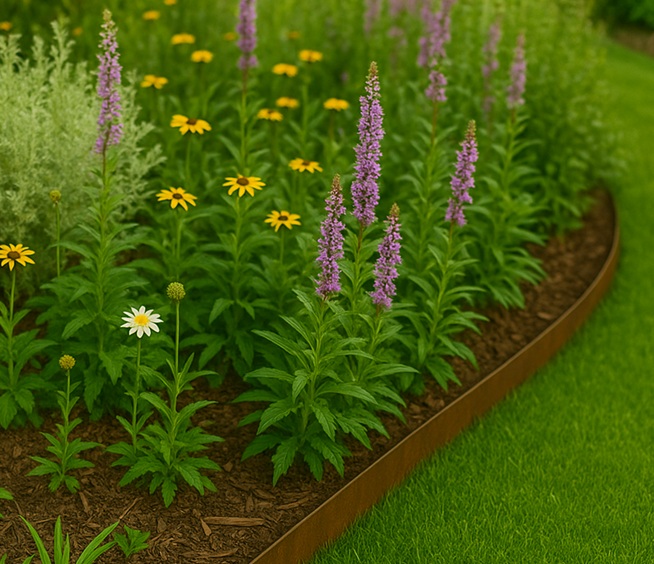No products in the cart.

Creating a garden that’s kind to the environment and inviting for local wildlife is a rewarding challenge. From native planting to pollinator habitats, every design choice plays a role in building an ecologically balanced space. One of the often-overlooked elements is Edging. We explore how metal edging not only enhances aesthetics but also contributes to the sustainability and functionality of wildlife-friendly gardens.
Why Edge a Wildlife Garden at All?
At first glance, formal borders and structured outlines might seem at odds with the free-flowing feel of a natural garden. However, smart edging serves several eco-conscious purposes:
- Reduces Soil Erosion: Prevents garden beds from washing out during heavy rain.
- Defines Habitat Zones: Helps separate native plant areas, pollinator gardens, grassed areas and pathways without large physical barriers that disrupt wildlife.
- Water retention: Keeps soil in place and does not absorb water from the soil as concrete edging does.
- Longevity: Using metal edging reduces the need for frequent replacement
Why Choose Metal Edging?
When it comes to edging materials, metal stands out as a top choice for sustainable landscapes. Here’s why:
Durability with a Light Footprint
Metal edging—especially steel or aluminium—can last decades without replacement. Its long life reduces the need for re-manufacturing and transportation compared to plastics or treated wood, which degrade or leach chemicals into the soil.
Recyclable and Recycled
Most metal edging is 100% recyclable and often contains recycled content. This means fewer raw resources are needed, and when the edging eventually reaches the end of its life, it won’t end up in a landfill.
Non-Toxic and Wildlife-Safe
Unlike some treated timber or composite products, metal doesn’t leach harmful substances. This makes it safer for:
- Burrowing animals like hedgehogs and rabbits
- Amphibians seeking shelter in moist areas
- Insect populations relying on clean, healthy soil
Low Profile, High Function
Metal edging is sleek and unobtrusive, which suits naturalistic garden aesthetics. Low-profile designs don’t block small animals’ movement, maintaining the flow of your wildlife corridors while still offering strong delineation for maintenance purposes.
Choosing the Right Metal for the Job
Not all metal edging is the same. Here are some of the most environmentally friendly options:
- Corten Steel: This material develops a rust-like patina that protects it from corrosion without any coatings or treatments. Ideal for rustic, natural designs.
- Galvanized Steel: Coated to resist rusting, it’s slightly shinier but highly resilient.
- Aluminium: Lightweight, rust-resistant, and easy to install, which makes it an ideal choice for all kinds of gardens
All these options come in flexible forms, ideal for curving around garden beds and pathways in organic shapes that mirror nature.
Installation Tips for Eco-Conscious Gardeners
- Go Tool-Free Where Possible: Our metal edging systems use interlocking pieces or stakes, minimizing soil disturbance and the need for heavy duty tools.
- Plan for Wildlife Flow: Leave small gaps at ground level or incorporate native groundcover that allows small animals to move freely.
- Choose the right season: Install during the dormant period of the year, ideally late autumn through to very early spring.
Pairing Edging with Sustainable Garden Design
Metal edging works beautifully alongside features like:
- Pollinator meadows
- Rain gardens and bioswales
- Perennial beds with native species
- Compost zones and organic mulch paths
It allows you to define these spaces clearly without disturbing the ecosystem’s balance.
Final Thoughts
Metal edging is a smart, sustainable choice for anyone designing a wildlife garden. Its durability, safety, and recyclability make it one of the most environmentally friendly hardscape materials available. By using it to define your garden areas, you support both the aesthetics and ecology of your outdoor space—inviting wildlife in while keeping your garden tidy and efficient.



